Combined Supporting Technology with Bolt-Grouting and Floor Pressure-Relief for Deep Chamber: An Underground Coal Mine Case Study
Abstract
:1. Introduction
2. Geological Engineering Condition of Head Chamber
3. Main Causes of Surrounding Rock Deformation in the Head Chamber
- (1)
- Chamber surrounding rocks are weak lithology and of low strength. The chamber is located in the roof-to-floor strata of the coal seam, and the lithology of surrounding rocks is mainly coal seam, sandy mudstone, and sandstone. According to the observation of the exposure surface during the chamber driving and drilling, the integrated histogram of surrounding rock of chamber is shown in Figure 2.
- (2)
- Buried depth of the chamber is 526 m with a high in situ stress.
- (3)
- The chamber was affected by the fixed abutment pressure of the shaft protective pillars. The inclined longwall working face is completed in both sides of the blind incline shaft, and the chamber is in the downhill of the protective pillars of the blind incline shaft with a pillar total width of 570 m.
4. Pressure-Relief Principle of Chamber Floor Pressure-Relief Slot
4.1. Pressure-Relief Principle and the Layout and Parameters of the Chamber Pressure-Relief Slot
4.1.1. Pressure-Relief Principle of Floor Pressure-Relief Slot
4.1.2. Layout and Parameters of Pressure-Relief Slot
4.2. Chamber Deformation Calculation Model When Opening the Floor Pressure-Relief Slot
4.2.1. Numerical Computational Mechanics Model
4.2.2. Physical and Mechanical Parameters of Chamber Surrounding Rock
4.3. Analysis on Numerical Simulation Calculation Results
4.3.1. Numerical Computational Mechanics Model
4.3.2. Changes of the Horizontal Stress Field and Displacement Field of the Chamber
5. Bolt-Grouting Reinforcement of Chamber and Pressure-Relief Industrial Test
5.1. Anchoring-Grouting Support and the Floor Pressure-Relief Slot Construction
5.2. Bolt-Grouting Reinforcement and Floor Pressure-Relief Effect
6. Conclusions
- (1)
- The surrounding rock of the No.2 belt conveyor head chamber at Xinzhuang coal mine is weak in both lithology and rock strength, and the abutment pressure of the blind incline shaft protective pillar induces the concentrated stress of the surrounding rock of the chamber. Therefore, the effective load coefficient of the surrounding rock of chamber is higher, which is one of the main reasons of the chamber floor heave and the surrounding rock deformation failure.
- (2)
- Numerical results showed that after the floor pressure-relief slot was excavated in the head chamber, the vertical stress of floor surrounding rock of chamber and the horizontal stress of sides surrounding rock were significantly reduced when compared with the stress before the pressure-relief, and the floor vertical displacement basically remains unchanged. This demonstrates that the floor pressure-relief slot can effectively control the chamber floor heave and is in favor of the long-term stability of the surrounding rock of the chamber.
- (3)
- When the head chamber was repaired, the combined support with the bolt-mesh-shotcreting and anchor cable was applied firstly. Then, the chamber sides and roof shallow surrounding rock were grouted by grouting bolts, and the chamber sides and floor deep surrounding rock were grouted by grouting anchor cable bundles. The chamber floor pressure-relief slot was excavated at last. After the implementation of the above integrated techniques, the surrounding rock of chamber was in a stable state, which suggested that the field test is successful. Therefore, it is reasonable to design and carry out the bolt grouting support and the floor pressure-relief slot of the chamber.
- (4)
- The combined supporting technology with bolt-grouting and floor pressure-relief effectively controls the surrounding rock stability of the deep head chamber at Xinzhuang coal mine. This technology can provide technical support for the deep roadway supporting under similar conditions. It has practical significance and reference value on the development of surrounding rock control theory and technology in the deep roadways.
Acknowledgments
Author Contributions
Conflicts of Interest
References
- Kovári, K. History of the sprayed concrete lining method—Part I: Milestones up to the 1960s. Tunn. Undergr. Space Technol. 2003, 18, 57–69. [Google Scholar] [CrossRef]
- Kovári, K. History of the sprayed concrete lining method—Part II: Milestones up to the 1960s. Tunn. Undergr. Space Technol. 2003, 18, 71–83. [Google Scholar] [CrossRef]
- Indraratna, B. Effect of bolts on failure modes near tunnel openings in soft rock. Geotechnique 1993, 43, 433–442. [Google Scholar] [CrossRef]
- Bobet, A.; Einstein, H.H. Tunnel reinforcement with rock bolts. Tunn. Undergr. Space Technol. 2011, 26, 100–123. [Google Scholar] [CrossRef]
- Kang, H.; Wu, Y.; Gao, F.; Lin, J.; Jiang, P. Fracture characteristics in rock bolts in underground coal mine roadways. Int. J. Rock Mech. Min. Sci. 2013, 62, 105–112. [Google Scholar] [CrossRef]
- Ju, W.J. Development and prospect of anchored-bolt supporting technology in Chinese coal mines. Coal Min. Technol. 2014, 19, 1–6. [Google Scholar] [CrossRef]
- Kang, H.P.; Wang, J.H.; Lin, J. Case studies of rock bolting in coal mine roadways. Chin. J. Rock Mech. Eng. 2010, 29, 649–664. [Google Scholar]
- Guo, D.M.; Wang, C.G.; Wu, Y.Y. Surrounding rock failure mechanism and technology of grouting reinforcement in winch chamber. Coal Sci. Technol. 2014, 42, 27–30. [Google Scholar] [CrossRef]
- Vižintin, G.; Mayer, J.; Lajlar, B.; Vukelič, Ž. Rock burst dependency on the type of steel arch support in the Velenje mine. Mater. Tehnol. 2017, 51, 11–18. [Google Scholar] [CrossRef]
- Vižintin, G.; Kocjančič, M.; Vulić, M. Study of coal burst source locations in the Velenje colliery. Energies 2016, 9, 507. [Google Scholar] [CrossRef]
- Vukelič, Ž.; Dervarič, E.; Šporin, J.; Vižintin, G. The development of dewatering predictions of the Velenje coal mine. Energies 2016, 9, 702. [Google Scholar] [CrossRef]
- Cai, Y.L.; Liu, C. Bolt and grouting combined reinforced support technology of large chamber in deep mine. Coal Sci. Technol. 2012, 40, 30–34. [Google Scholar] [CrossRef]
- Meng, Q.B.; Han, L.J.; Qiao, W.G. The deformation failure mechanism and control techniques of soft rock in deep roadways in Zhaolou mine. J. Min. Saf. Eng. 2013, 30, 165–172. [Google Scholar]
- Gao, M.S.; Zhang, N.; Guo, C.S.; Dou, L.M. Mechanics and practice of combined supporting technology of 3D anchor-cable and unloading technology of wall of roadway. Chin. J. Geotech. Eng. 2005, 27, 587–590. [Google Scholar]
- Zhang, X.Y. Deformation Mechanism and Pressure Relief of Surrounding Rock of Main Roadway under Dynamic Pressure. Master’s Thesis, Anhui University of Science and Technology, Huainan, China, 2007. [Google Scholar]
- LI, C.C. Field observations of rock bolts in high stress rock masses. Rock Mech. Rock Eng. 2010, 43, 491–496. [Google Scholar] [CrossRef]
- Shen, J. Pressure-relief and support technology of large-section chamber in soft rock. Coal Eng. 2011, 58, 67–68. [Google Scholar]
- Yang, Q.S.; Gao, M.S.; Liu, B.T. Study and practices on floor heave prevention and control mechanism with pressure releasing slot in floor of mine high stressed roadway. Coal Eng. 2011, 58, 69–71. [Google Scholar]
- Chen, H.; Liu, A.; Wu, Y. Pressure relief supporting technology for full section deep soft rock roadway with large deformation. Saf. Coal Mines 2015, 46, 136–138. [Google Scholar] [CrossRef]
- Zhai, X.X.; Yang, X.L.; Zeng, X.T. Relationship between deformation failure of blind incline shafts and their safety pillars. Min. Metall. Eng. 2003, 23, 20–22. [Google Scholar]
- Du, J.P.; Jiang, X.Y.; Qian, M.G. The application of effective load coefficient to the deep mining in Suncun colliery. Chin. J. Rock Mech. Eng. 1994, 13, 365–373. [Google Scholar]
- Kang, H.P. Simulation and practice of roof pressure relief on soft chamber. Mine Constr. Technol. 1993, 14, 32–35. [Google Scholar]
- Wang, X.F.; Gao, M.Z. Analysis on numerical simulation of pressure releasing slots in different location of mine high stress and soft rock roadway. Saf. Coal Mines 2013, 44, 76–79. [Google Scholar]
- Wang, X.F.; Zhang, D.S.; Chen, J.X. Numerical analysis on slotted reinforcement floor to control floor heave of soft rock chamber. Coal Eng. 2006, 53, 61–63. [Google Scholar]
- Yang, Z.B. Reasonable depth analysis of floor pressure-relief trough of large-section chamber in soft rock. Min. Saf. Environ. Prot. 2011, 38, 46–48. [Google Scholar]
- Li, W.T.; Yang, N.; Li, T.C.; Zhang, Y.H.; Wang, G. A new approach to simulate the supporting arch in a tunnel based on improvement of the beam element in FLAC3D. J. Zhejiang Univ. Sci. A Appl. Phys. Eng. 2017, 18, 179–193. [Google Scholar] [CrossRef]
- Zhuo, X.D.; Cui, W. Numerical simulation on high-strength pre-stressing force support for roadway surrounding rock based on Flac3D. Saf. Coal Mines 2016, 47, 210–212. [Google Scholar] [CrossRef]
- Peng, S.S. Coal Mine Ground Control; China University of Mining and Technology Press: Xuzhou, China, 2013. [Google Scholar]
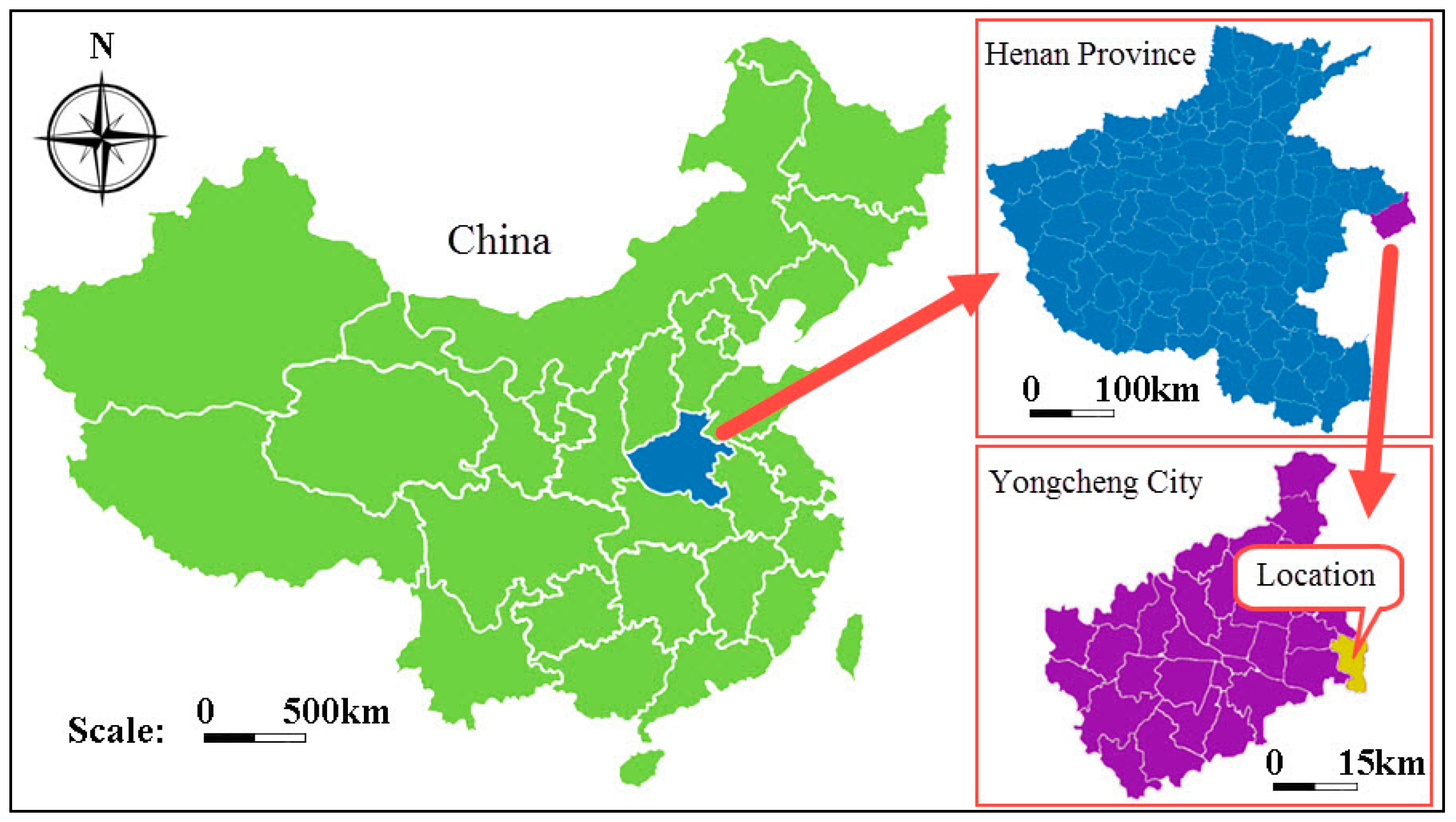

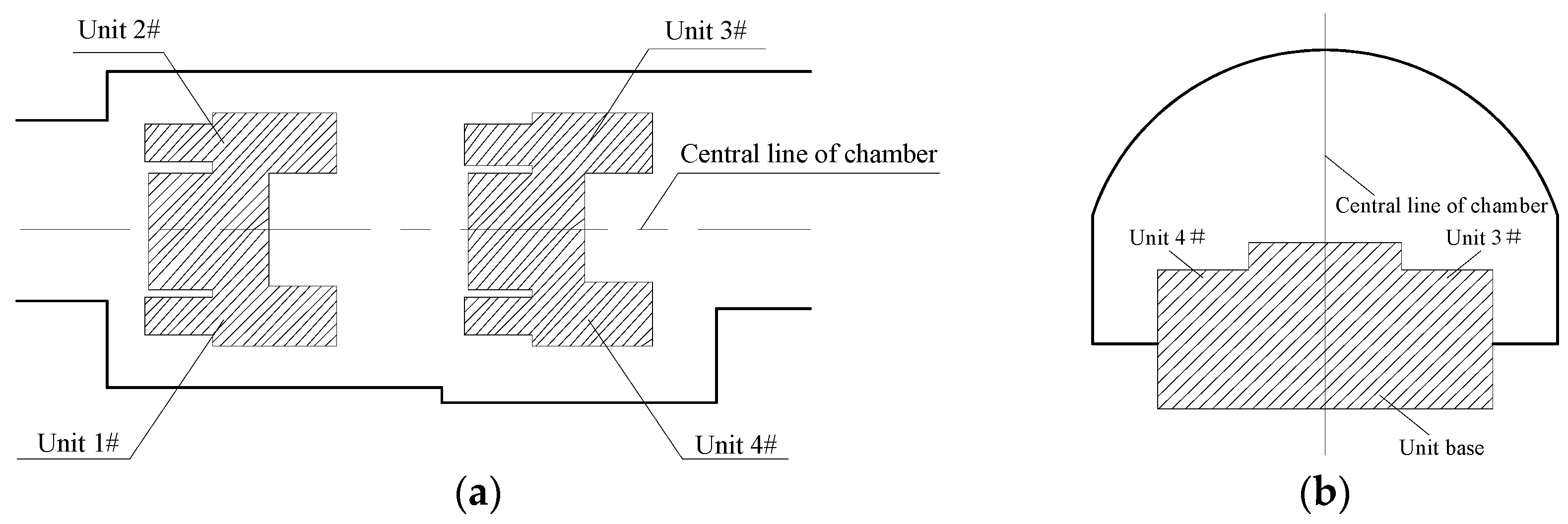
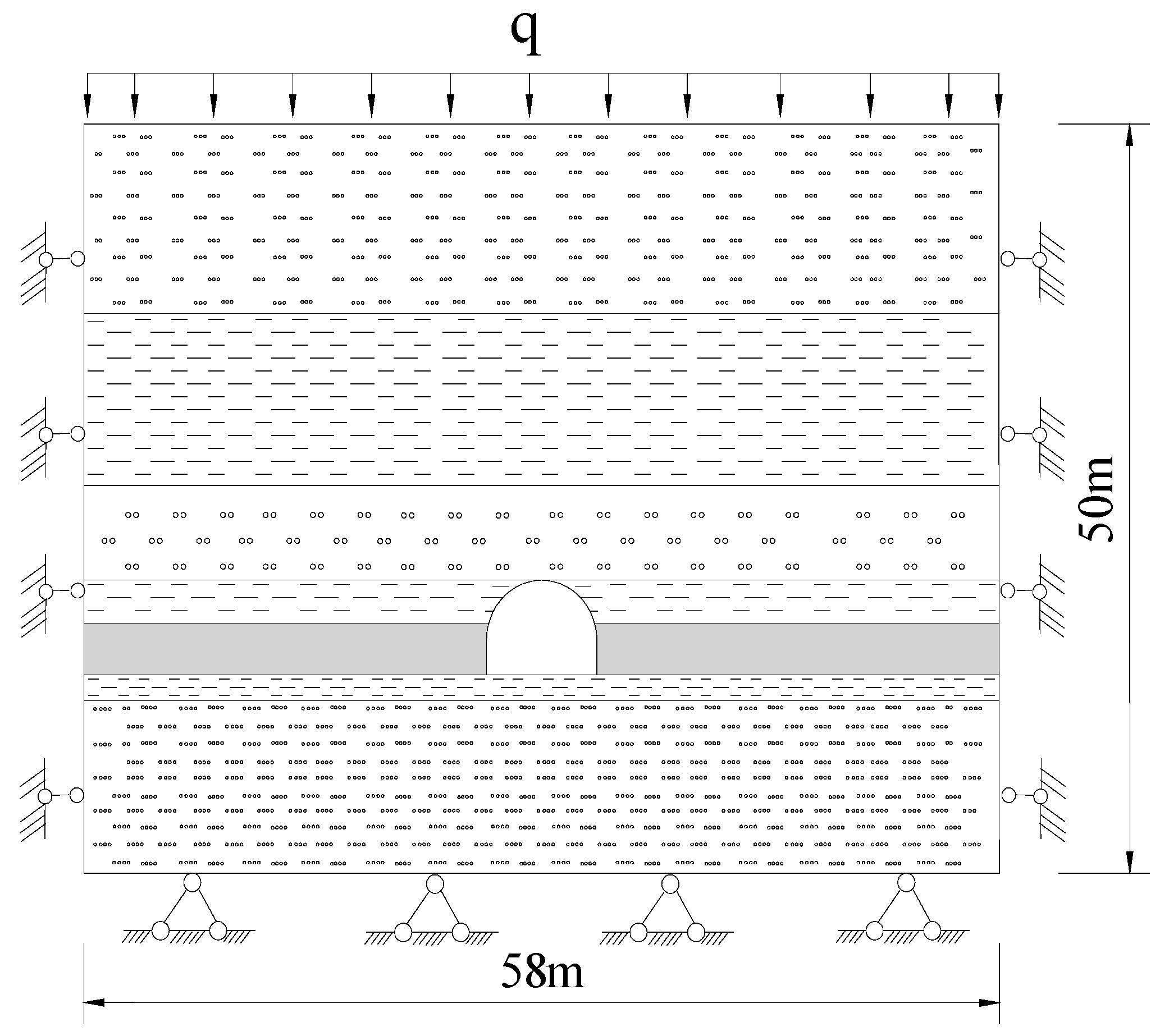
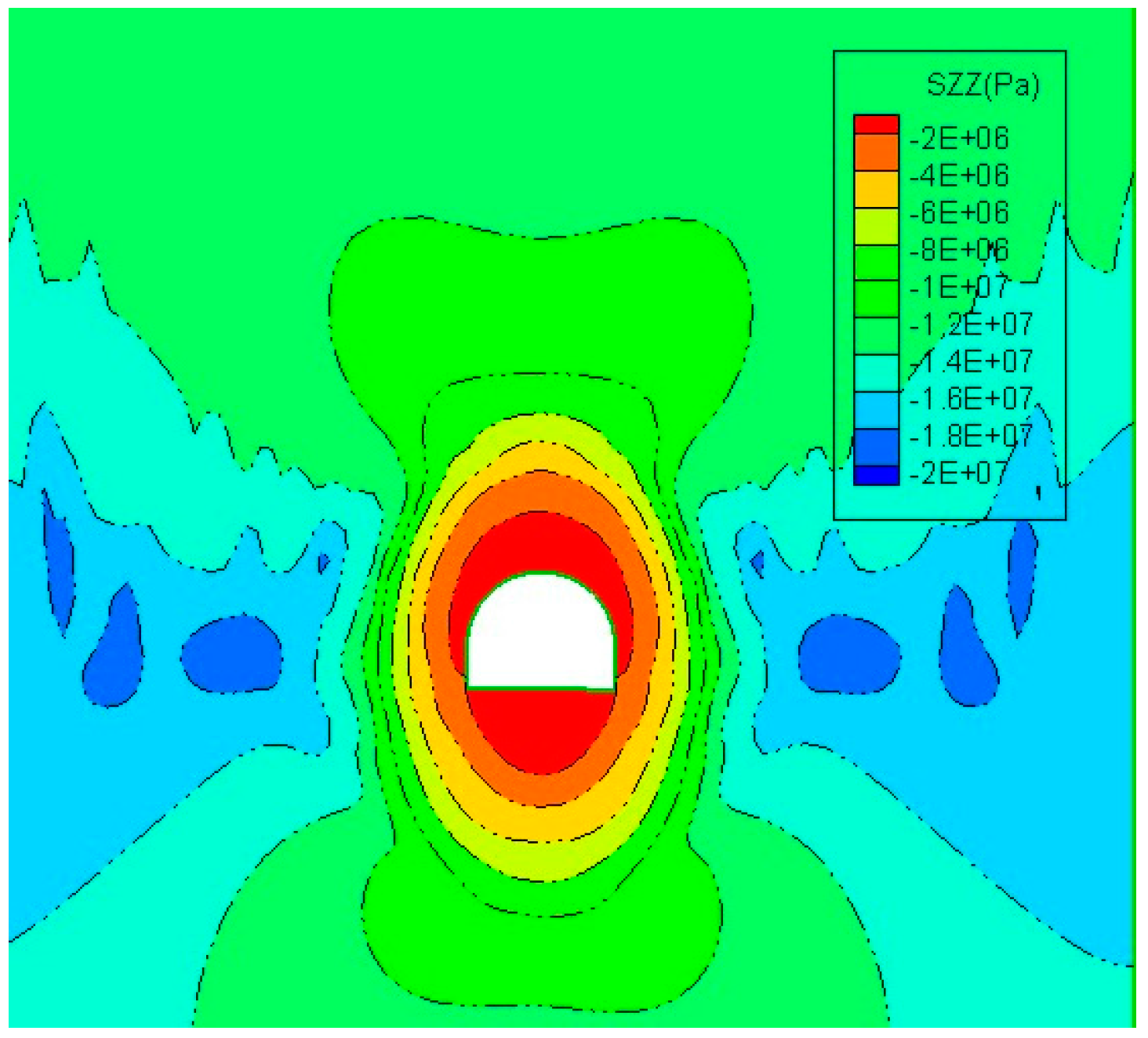
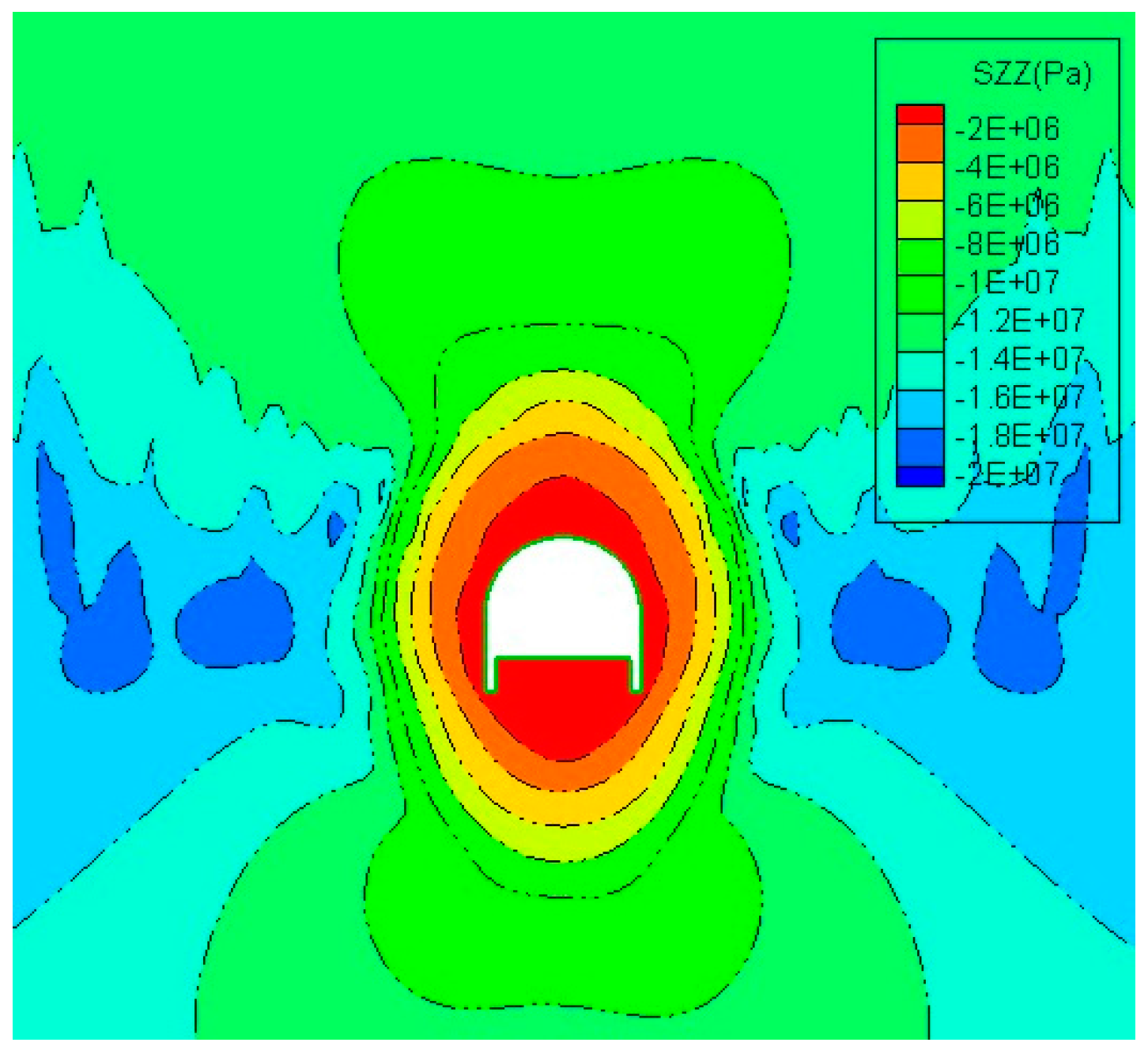


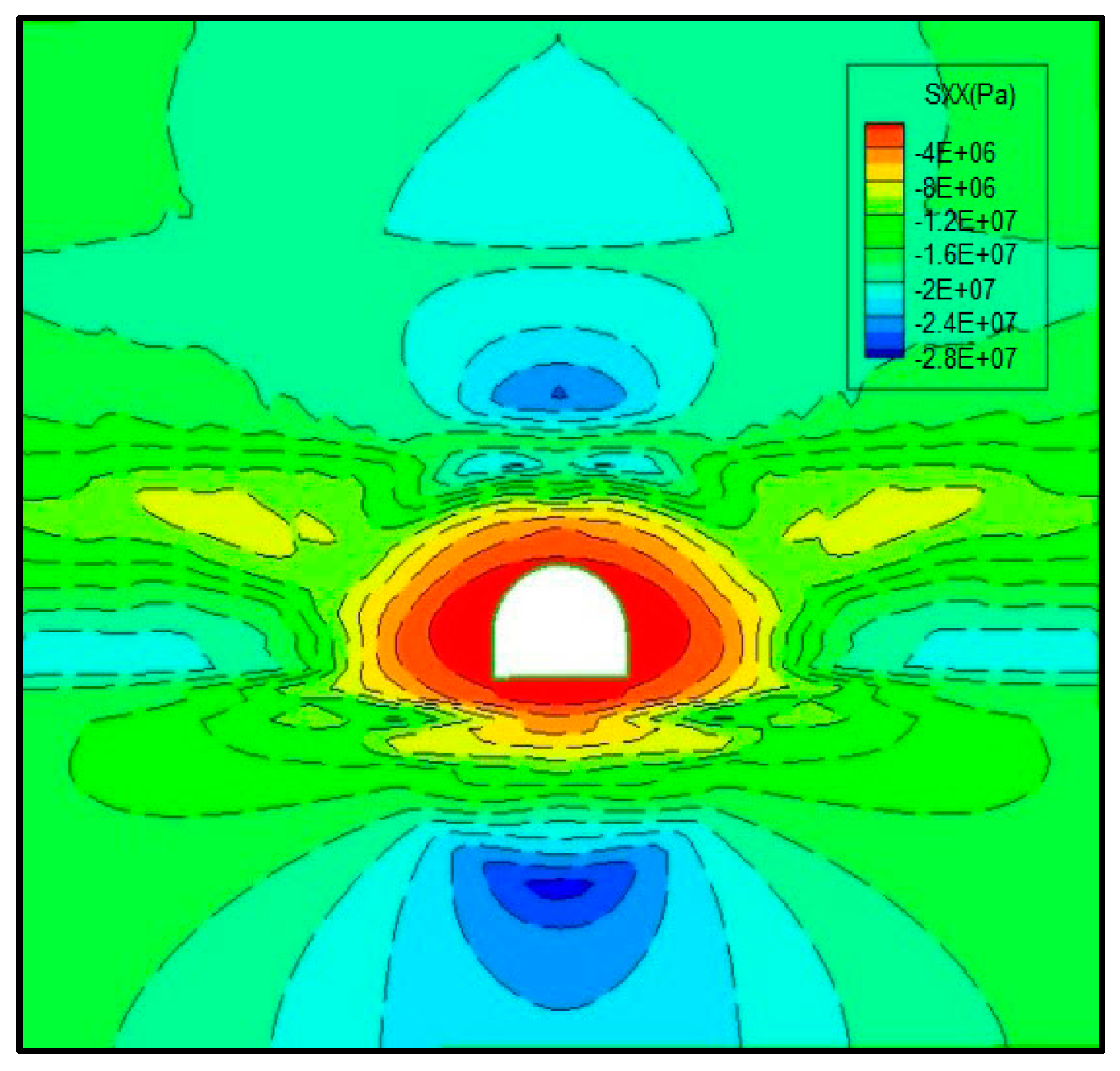
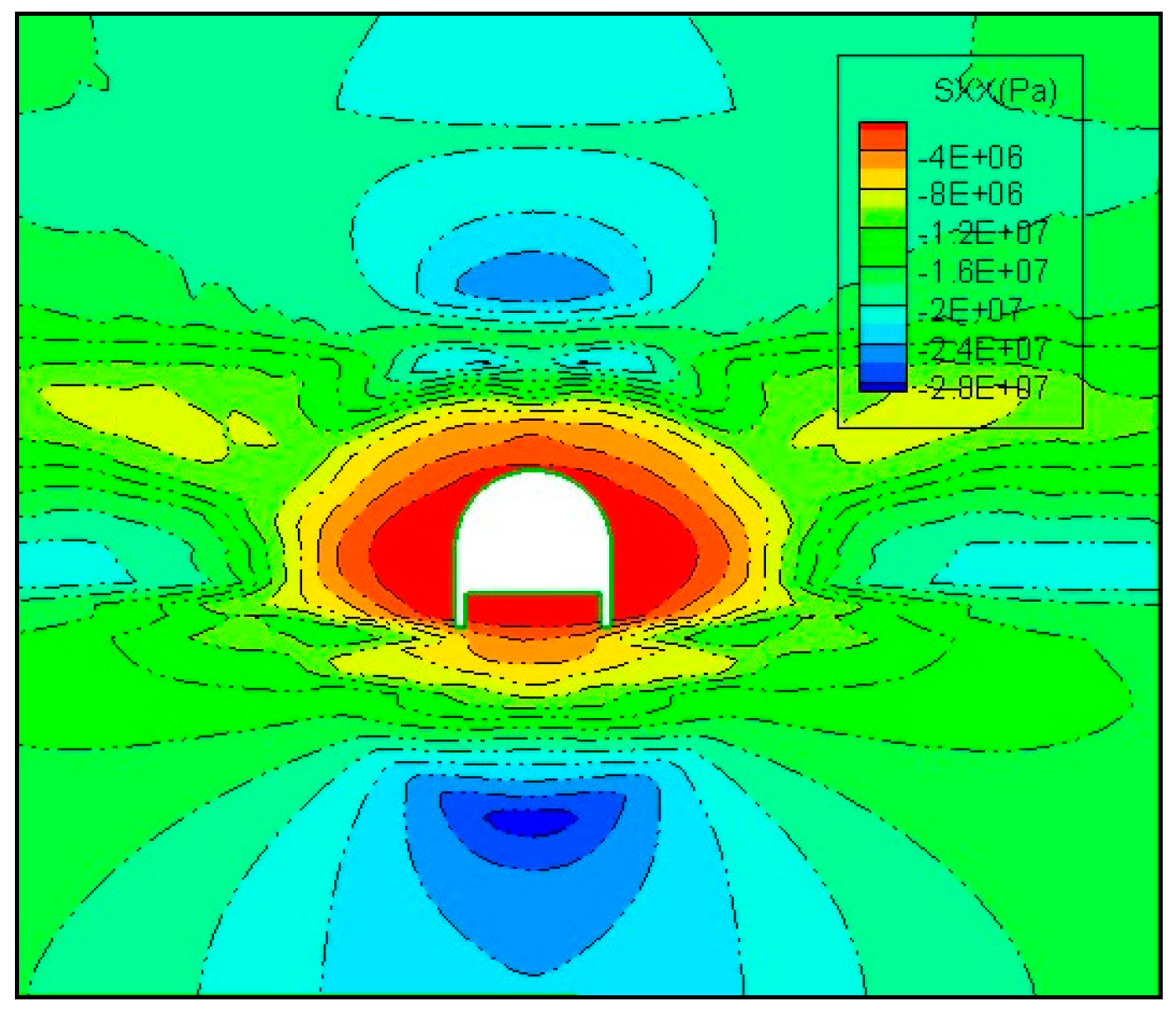

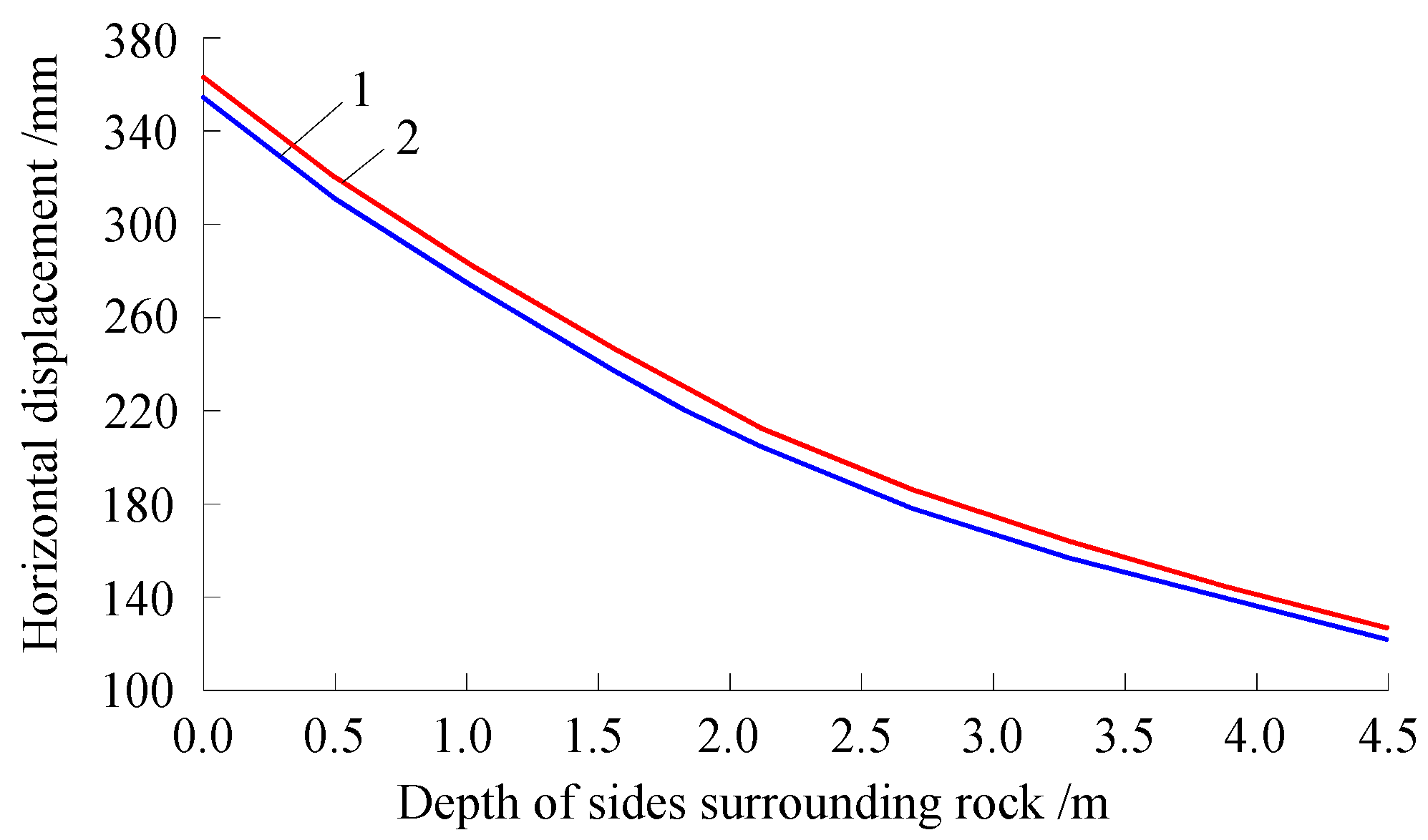
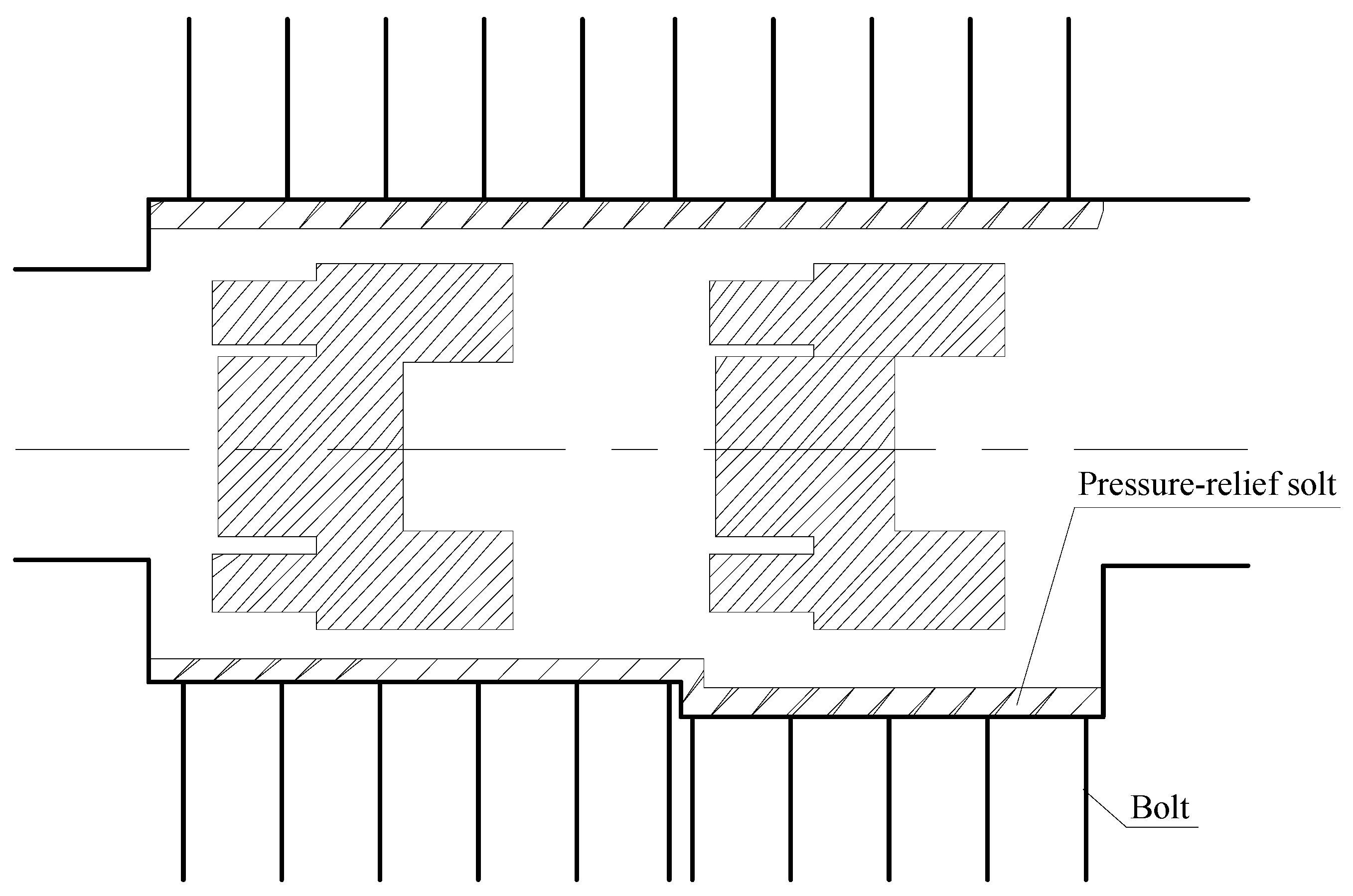
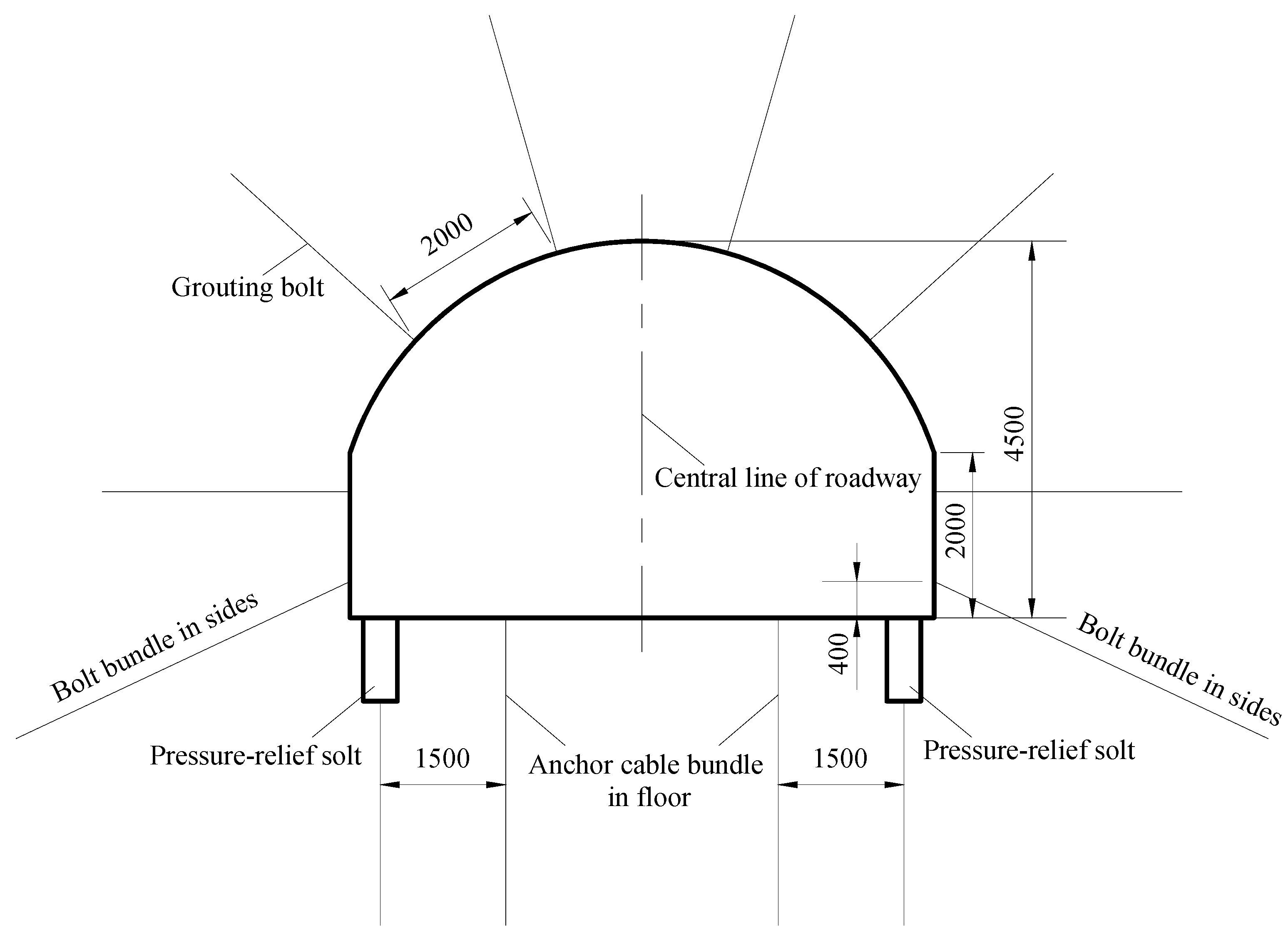
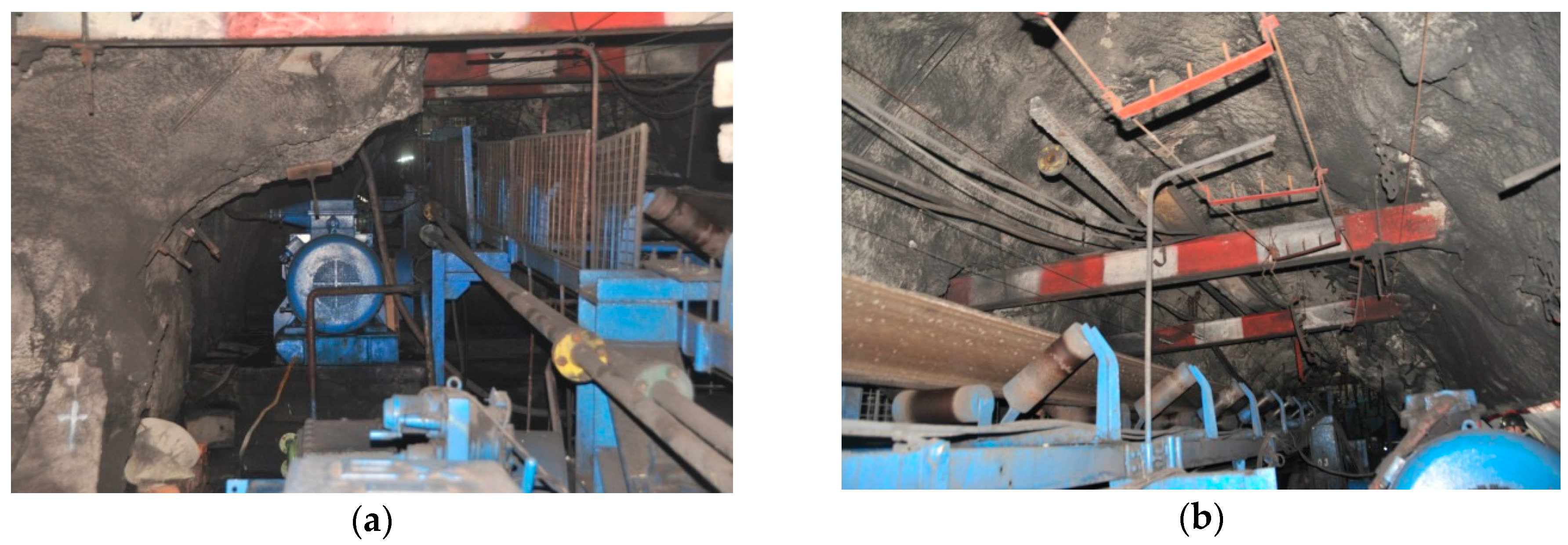


| Parameters | Thickness (m) | Bulk Modulus (GPa) | Shear Modulus (GPa) | Tensile Strength (MPa) | Cohesion (MPa) | Internal Friction Angle (°) | |
|---|---|---|---|---|---|---|---|
| Lithology | |||||||
| Fine-grained sandstone | 11.0 | 14.00 | 6.46 | 2.20 | 0.37 | 44.6 | |
| Sandy mudstone | 10.0 | 1.34 | 1.09 | 0.82 | 0.28 | 29.2 | |
| Medium-grained sandstone | 5.5 | 5.31 | 3.50 | 1.40 | 0.31 | 39.8 | |
| Sandy mudstone | 2.5 | 1.34 | 1.09 | 0.82 | 0.28 | 29.2 | |
| Coal seam II-2 | 3.0 | 0.57 | 0.26 | 0.08 | 0.40 | 30.5 | |
| Sandy mudstone | 1.5 | 1.34 | 1.09 | 0.82 | 0.28 | 29.2 | |
| Siltstone | 16.5 | 1.70 | 1.50 | 2.10 | 1.20 | 30.0 | |
© 2018 by the authors. Licensee MDPI, Basel, Switzerland. This article is an open access article distributed under the terms and conditions of the Creative Commons Attribution (CC BY) license (http://creativecommons.org/licenses/by/4.0/).
Share and Cite
Zhai, X.; Huang, G.; Chen, C.; Li, R. Combined Supporting Technology with Bolt-Grouting and Floor Pressure-Relief for Deep Chamber: An Underground Coal Mine Case Study. Energies 2018, 11, 67. https://doi.org/10.3390/en11010067
Zhai X, Huang G, Chen C, Li R. Combined Supporting Technology with Bolt-Grouting and Floor Pressure-Relief for Deep Chamber: An Underground Coal Mine Case Study. Energies. 2018; 11(1):67. https://doi.org/10.3390/en11010067
Chicago/Turabian StyleZhai, Xinxian, Guangshuai Huang, Chengyu Chen, and Rubo Li. 2018. "Combined Supporting Technology with Bolt-Grouting and Floor Pressure-Relief for Deep Chamber: An Underground Coal Mine Case Study" Energies 11, no. 1: 67. https://doi.org/10.3390/en11010067




